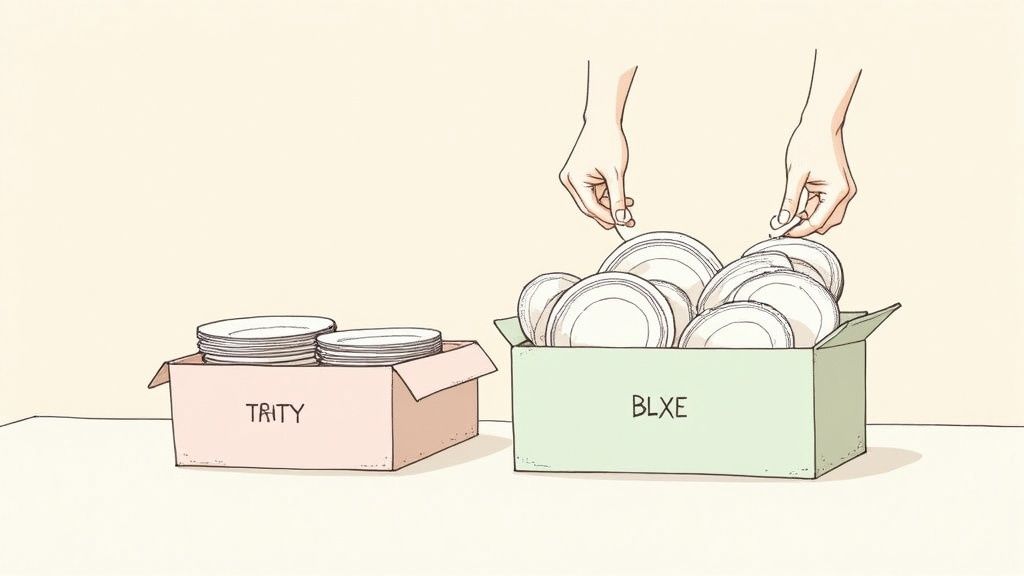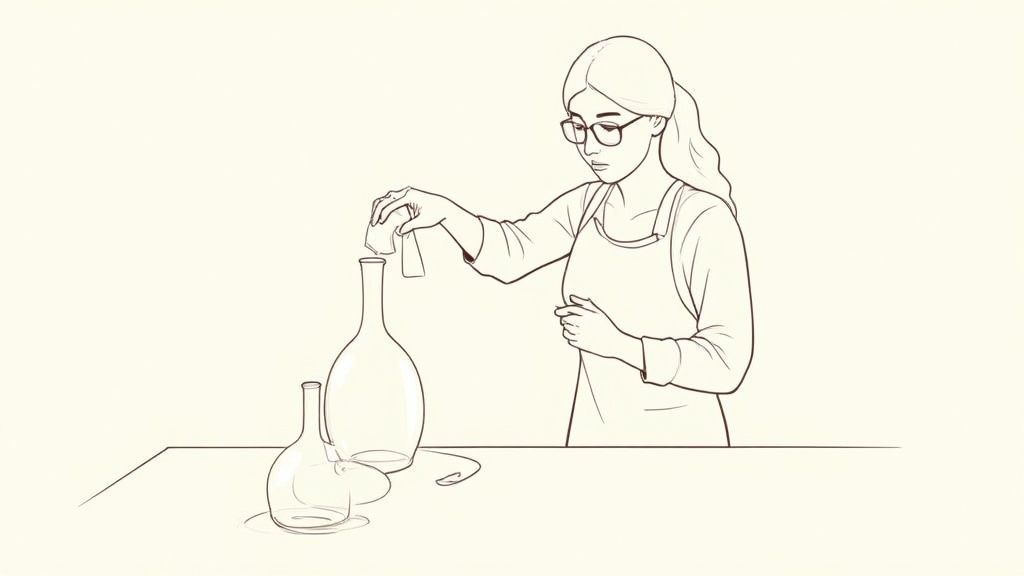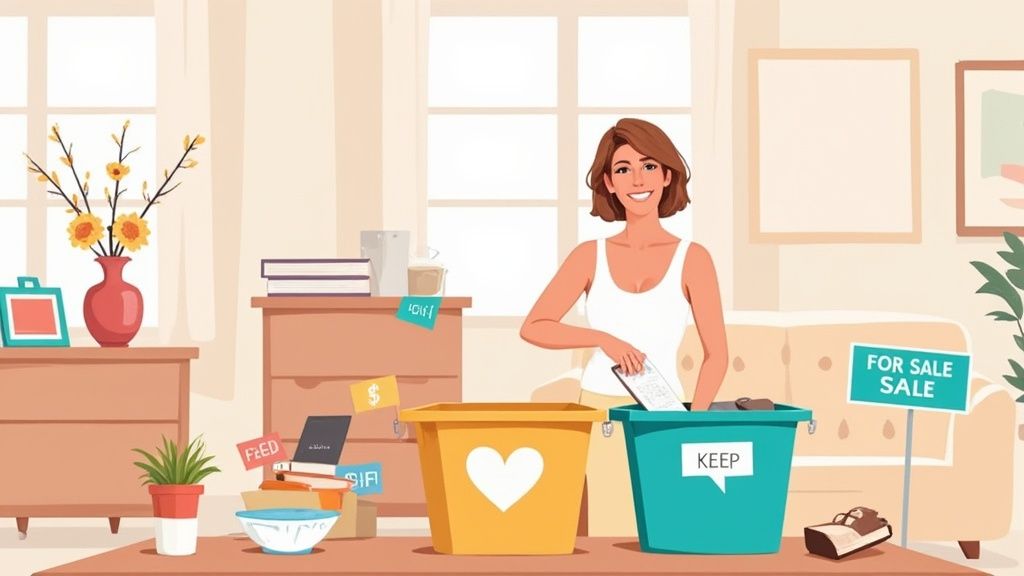Getting ready for an estate sale always starts with one big decision: are you going to run it yourself, or are you bringing in the pros? This choice really sets the tone for everything that follows, and it’s about more than just money—it’s about your time, your emotional energy, and your own expertise.
Your First Steps in Estate Sale Preparation
Staring down an entire house of belongings can feel overwhelming. The key is to break it down. The very first question to answer is whether to manage the sale on your own (DIY) or hire an experienced estate sale company. This isn't just a practical choice; it's a deeply personal one that depends entirely on your situation.
Going the DIY route gives you total control, and you get to keep 100% of the profits. But make no mistake, it's a massive commitment. You'll be the one sorting through years—sometimes decades—of possessions, researching and pricing every item, and then staging the home and marketing the sale. It can be physically and emotionally exhausting, especially when you're handling a loved one's things.
Choosing Your Path: DIY vs. Professional Help
Hiring a professional estate sale company, on the other hand, takes most of that weight off your shoulders. These companies work on commission, usually taking 30% to 50% of the total sales, but they bring a ton of experience to the table. They know what things are worth, have a built-in network of buyers, and manage all the logistics from start to finish.
The biggest advantage professionals offer is a bit of emotional distance. They can look at a cherished rocking chair or a set of old china and see its market value, not just its sentimental value. This objectivity is often the key to a more successful and less painful sale.
Before you even touch a single box, a few critical conversations need to happen. Getting these things sorted out upfront will prevent a world of headaches later on.
- Confirm Legal Authority: First things first, make sure you actually have the legal right to sell the estate's assets. This usually means you're the executor named in the will or have been appointed by the court.
- Talk to the Family: Get all the heirs and family members on the same page. Decide what, if anything, people want to keep. Being transparent about the plan is the best way to keep the peace.
- Set Clear Goals: What’s the main goal here? Are you trying to get the absolute highest price for everything, or do you just need to clear the house out as quickly as possible? Knowing your priority will help guide your decisions.
After you've made these initial choices and had these important talks, you can start digging into the hands-on work. For a complete look at what's next, check out our guide on how to organize an estate sale for a step-by-step plan.
The Emotional and Practical Realities
Be honest with yourself about the emotional side of this. Sifting through a lifetime of memories is tough. If the idea of strangers going through personal belongings is too much to handle, or if you simply don't have the time, hiring a company is a smart move for your own well-being.
But if you're an organized person who enjoys a good project and has friends or family willing to pitch in, a DIY sale can be incredibly rewarding. These first steps—choosing your path and getting aligned with family—are the foundation for a smooth process, no matter which direction you go.
The Art of Sorting and Organizing Possessions

With the initial planning out of the way, it's time to roll up your sleeves and get to work. This is the part of the process that’s both physical and emotional, turning a lifetime of belongings into an organized, shoppable space. The sheer volume of stuff can feel like a tidal wave, but trust me, a systematic approach is your best defense against feeling completely overwhelmed.
My best advice? Tackle the house one room at a time. It’s a simple containment strategy that stops you from just shifting piles around. You’ll feel a real sense of accomplishment as you check each room off your list, building the momentum you need to see the project through.
Implement a Clear Sorting System
To bring some order to the chaos, you need a sorting system that is simple and forces you to make a decision on every single item. I’ve always found the classic three-category method works wonders for this.
Grab some different colored bins or just designate corners of the room for each category:
- Sell: Anything you believe has resale value and is a good fit for the sale goes here.
- Keep: This pile is for items the family has decided to hang onto. It’s absolutely vital to have these discussions before you start sorting to prevent disagreements down the line.
- Donate/Discard: This is for items that aren't valuable enough to sell but are in good shape for donation, along with anything that’s broken, stained, or otherwise unsellable.
This approach gets rid of the dreaded "maybe" pile, which is where progress usually grinds to a halt. As you go, be realistic but firm. Not everything is going to sell, and that’s perfectly fine. The goal is to process the home's contents efficiently.
Pro Tip: The very first thing you should do in any room is find and secure all personal documents. Photographs, letters, financial records, and legal papers should never be left out. Box them up and move them somewhere safe early on to protect privacy and prevent them from being sold by mistake.
Group and Categorize for Staging
As your "Sell" pile starts to grow, don't wait to start the next step. Instead of letting it become one massive, jumbled heap, begin grouping similar items together. It’s a small, proactive step that will save you a ton of time and headaches when it comes to pricing and staging.
Think like a retail manager. Gather all the kitchen glassware in one spot, all the linens and towels in another, and all the garage tools together. This initial grouping gives you a much clearer picture of your inventory.
The Initial Inventory and Pre-Cleaning
Creating these collections doesn't just make staging easier; it’s the foundation of your inventory list. You don't need to count every single teaspoon, but jotting down notes like "approx. 20 pieces of silverplate flatware" or "set of 8 crystal water goblets" creates a working list for the valuation stage.
This is also the perfect time for some light cleaning. A bit of dusting or a quick wipe-down can have a huge impact on an item's appearance and perceived value. You aren't doing a deep restoration—in fact, that can actually hurt the value of certain antiques. You're just removing the surface grime to make things more appealing.
Think about it this way: a potential buyer might walk right past a dusty, tarnished silver tray. But give that same tray a quick polish to let it shine, and it suddenly looks like a fantastic find. This small bit of effort is what transforms "clutter" into "treasure" in a shopper's eyes. This isn't just tidying up; it's the first step in maximizing what you’ll earn from the sale.
Valuing and Pricing Items for Maximum Return

After you’ve sorted through a lifetime of possessions, you’ll face what is arguably the most critical part of planning an estate sale: putting a price on everything. This is where the rubber meets the road. The prices you set will ultimately determine the sale's success.
Go too high, and you risk ending the weekend with a house full of things you still need to get rid of. Go too low, and you're leaving cash on the table. It's a delicate balance that takes a bit of research, a healthy dose of objectivity, and a clear strategy.
The first step? Acknowledge what you don't know. Most people aren’t experts on 18th-century furniture, fine art, or rare comic books. For those potentially high-value items, guessing is a recipe for regret.
When to Call in a Professional Appraiser
For certain categories, bringing in a certified appraiser isn't just a good idea—it's essential. Their trained eye can spot hidden gems and provide the documentation to back up a high price tag, which can be a lifesaver if family members question the final sale amounts.
You should seriously consider hiring an appraiser for items like:
- Fine Jewelry and Watches: Think unique designer pieces, antique watches, or anything with significant precious metals and gems.
- Artwork and Sculptures: This includes original paintings, signed prints, or sculptures by known artists.
- Antique Furniture: Pieces from specific, desirable periods (like mid-century modern or Victorian) or items made by a famous designer.
- Major Collections: Large, well-cared-for collections of stamps, coins, first-edition books, or other valuable memorabilia.
An appraiser's fee might feel like just another expense, but their ability to identify a rare $5,000 piece you might have marked for $100 makes the investment pay for itself. A formal report also adds a layer of professionalism and accountability to the whole process.
Researching Everyday Items Like a Pro
For the bulk of what's in a home—the kitchenware, linens, everyday furniture, and tools—you can absolutely do the research yourself. The key is to find the current market value, not the original price someone paid or what you feel an item is worth. This is business, so you have to set emotional attachment aside.
One of the best ways to find realistic prices is to look at what items have actually sold for, not what sellers are asking. Online marketplaces are your best friend here.
Here's a simple, effective method:
- Head over to eBay and search for an item similar to yours.
- In the filter menu (usually on the left), scroll down until you see an option for "Sold Items" and check that box.
- The results will now show you what real buyers have recently paid for that item.
This trick works for almost anything you can think of, from vintage Pyrex to a used Black & Decker drill. Just remember that condition is everything. Be brutally honest about any scuffs, chips, or wear when comparing your item to the ones you see online.
The Psychology of Estate Sale Pricing
Once your research is done, it's time to actually tag the items. This is more than just writing down a number; it’s about understanding how estate sale shoppers think. They're on a treasure hunt, and they absolutely love the thrill of a good haggle.
A smart move is to price items fairly but leave a little bit of wiggle room for negotiation. If your research shows a lamp consistently sells for around $40, pricing it at $45 or $50 gives you space to accept a lower offer while still hitting your target. The buyer walks away feeling like they scored a deal, which often encourages them to keep shopping. For a deeper look at these tactics, check out our guide on how to price estate sale items effectively.
Whatever you do, don't grossly overprice everything with the plan of offering huge discounts later. Shoppers are sharp. If everything seems ridiculously expensive on day one, many won't even bother coming back for the markdown days. Your initial pricing sets the tone for the entire event, so aim for fair market value right out of the gate to build trust and keep people browsing.
Staging and Marketing Your Estate Sale Effectively

Once you’ve sorted and priced everything, you enter the home stretch: presentation. This is where the magic really happens. How you stage the home and market the sale are the two biggest factors that will determine the size of your crowds and, ultimately, your final profits.
Think of it like this: you're temporarily turning a private home into a retail shop. Your job is to create an experience that makes shoppers feel welcome, allows them to browse easily, and gets them excited to buy. It all starts with a deep clean. Dust, grime, and clutter can make even the most valuable antiques look like junk, so don't cut corners here. Make everything sparkle.
Creating an Irresistible Shopping Environment
With a clean slate, you can start arranging items thoughtfully. Resist the urge to just pile things on tables. Instead, create little scenes, or vignettes, that help people see how these items could fit into their own lives. This small shift in approach is what separates a mediocre sale from a great one.
Here are a few ideas I've seen work wonders:
- Set the Scene: Arrange the dining table with a full set of dishes, silverware, and glassware as if you’re about to host a dinner party.
- Create a Cozy Nook: Pair a comfortable armchair with a side table, a reading lamp, and a few interesting books.
- Group by Theme: Put all the holiday decor in one corner or all the gardening supplies together in the garage. It makes shopping so much easier.
This kind of staging does more than just look nice—it sells. It elevates items from being mere "stuff" into pieces of a desirable lifestyle. Just as important, make sure you create clear, wide pathways for people to move around. Nothing frustrates a shopper more than a cramped space they can't navigate.
Remember, you aren't just selling objects; you're selling the idea of them. A beautifully staged setting can dramatically boost an item's perceived value and make it infinitely more desirable. People are far more likely to buy something they can already picture in their own home.
The Bigger Picture: Presentation and Property Value
Staging isn't just about the items themselves; it also reflects on the house, which is especially critical if the property is also going on the market. The home's overall atmosphere can subtly influence a buyer's mood and their perception of value.
This is where a little market knowledge can give you an edge. The U.S. residential real estate market, valued at a staggering $106.7 trillion after a 48.8% jump since 2019, proves just how much property presentation matters. Even with affordability issues and low inventory, a well-presented home stands out. For instance, knowing that 85% of real estate experts recommend soft white paint colors to increase a home's value can help you create a neutral, bright backdrop that makes both the sale items and the property itself look their absolute best. For a deeper dive, it's always smart to review the latest real estate statistics and trends.
Promoting Your Sale to Get a Great Turnout
Even the most perfectly staged sale will be a bust if nobody knows about it. You have to spread the word effectively to the right people, and a mix of marketing channels is the only way to go. Start your promotional blitz about one to two weeks before the sale.
Table: Marketing Channel Effectiveness for Estate Sales
Choosing where to spend your time and money on advertising can feel overwhelming. This table breaks down the most common channels to help you focus your efforts for the best results.
| Channel | Reach | Target Audience | Cost | Best For |
|---|---|---|---|---|
| EstateSales.net | National, high | Dedicated estate sale shoppers, collectors | $ | Reaching serious, ready-to-buy customers. A must-have. |
| Facebook Marketplace | Local, very high | General bargain hunters, local community | Free | Casting a wide local net with lots of photos. |
| Craigslist | Local, high | Budget-conscious shoppers, specific item seekers | Free | A classic that still pulls in a significant number of people. |
| Nextdoor | Hyper-local | Immediate neighbors, nearby community | Free | Spreading the word to the closest potential customers. |
| Physical Signs | Hyper-local | Drive-by traffic, impulse shoppers | $$ | Capturing weekend traffic and guiding people to the location. |
As you can see, a combination of online listings and physical signs is the gold standard for getting the word out and ensuring a successful, well-attended sale.
Digital Marketing That Draws a Crowd
Your online listings are your digital storefront. Specialized sites like EstateSales.net are essential—they are the first place serious buyers look. After that, hit the high-traffic local spots like Facebook Marketplace, neighborhood groups, and the "Garage & Moving Sales" section on Craigslist.
Your ads need to be compelling. Craft a headline that grabs attention: "Packed [Neighborhood] Estate Sale - Mid-Century Furniture, Antiques, Tools." In the description, list the types of items available and, most importantly, upload dozens of high-quality, well-lit photos. Showcase your best pieces to create a sense of excitement and prove the sale is worth their time.
The Unbeatable Power of Old-Fashioned Signs
Never, ever underestimate the power of a good sign. A huge chunk of your weekend traffic will come from people just driving by. Your signs are your secret weapon for capturing this local audience.
Don't cheap out here. Flimsy poster board and markers that run in the rain won't cut it. Invest in professional, weather-resistant signs with:
- Bold, Clear Text: Use a simple font that’s readable from a moving car. "ESTATE SALE" should be the biggest text on there.
- Minimal Info: Just the address and the dates/times. Keep it simple.
- Big, Obvious Arrows: Guide drivers from the nearest main road right to the front door.
Place your signs at every major intersection and key turn. On the morning of the sale, take a few minutes to drive the route yourself. Make sure every sign is still standing, visible, and pointing the right way. This final check can make a massive difference in your turnout.
Navigating Sale Days and Post-Sale Logistics

After all the weeks of sorting, pricing, and staging, the big event is finally here. I can't stress this enough: how the sale days unfold comes down entirely to your preparation. This is not a one-person job. Trying to manage a house full of shoppers by yourself is a surefire recipe for chaos and lost money.
You'll need a solid team of helpers, whether that's family, friends, or a bit of hired help. Give everyone a specific role. For example, station one person in each key area—like the living room or garage—to answer questions and keep a watchful eye. Have another person designated as a "floater" to help buyers carry large items to the checkout.
Managing the Flow of Shoppers and Money
One of the most critical parts of your setup is a single, clearly marked checkout area. I’ve found the best spot is almost always near the main exit. It just makes sense—it streamlines payments and drastically improves your security by creating a natural bottleneck.
Your checkout station needs to be ready for how people pay today. While cash is great, you absolutely must be set up for digital payments. Services like Square or Venmo are incredibly easy to get going on your phone and will save you from losing sales from people who don't carry much cash.
Here's a quick checklist of what I always have at my checkout table:
- A cash box with a good float of small bills and coins for making change.
- A smartphone or tablet with a payment app like Square or PayPal already set up and tested. Don't wait until the first customer is in front of you to figure it out!
- Plenty of bags and wrapping materials like newspaper or bubble wrap for delicate items.
- A "Sold" tag system for large furniture pieces that people will need to pick up later.
A well-run checkout process does more than just process payments; it projects professionalism. When shoppers see an efficient setup, they feel more confident and are often more comfortable circling back for another look.
The Art of the Discount Strategy
Discounts aren't just a good idea; they're an expected part of any estate sale. A smart markdown plan is your best tool for clearing out the house before the doors close for good. The most effective approach I've used time and again is a tiered discount schedule.
A classic model looks something like this:
- Day One: Full price. This is for the early birds and die-hard pickers who want the best selection.
- Day Two: 25% off most items. This brings back the people who were on the fence about something yesterday.
- Final Day/Hours: 50% off or even more. At this point, the goal is pure liquidation. Your goal is to turn stuff into cash.
Make your discount policy crystal clear with signs. This transparency stops endless haggling over every single item and keeps the energy of the sale positive and moving.
After the Sale: The Final Steps
Your work isn't quite done when the last customer walks out the door. Now it's time to deal with what's left. Having a plan for the leftovers is a crucial part of knowing how to prepare for an estate sale from start to finish.
First, quickly sort what's left into a few piles. This will help you figure out the best way to clear the house. You've got a few solid options:
- Donation: Many charities like Goodwill or Habitat for Humanity ReStore offer free pickup for big donations. This is a huge time-saver.
- Buyout: You can call an estate sale liquidator or a junk removal company that offers a buyout service. They'll give you a single price for everything that's left and handle the entire clean-out.
- Consignment: If you have a few high-value items that didn't sell, taking them to a local consignment shop can be a smart move.
Once the house is empty, your last jobs are a good, thorough cleaning and the final accounting. Tally up all your sales and subtract your expenses, like advertising or appraisal fees. It's also smart to be informed about your local rules; understanding the basics of estate sale laws and tax implications can save you a headache later. This final tally gives you closure and a clear picture of just how successful your sale was.
Answering Your Top Estate Sale Questions
Even the best-laid plans run into questions. It’s just part of the process. When you’re staring down a house full of stuff, a lot of "what ifs" and "should Is" are bound to pop up. Let's tackle some of the most common ones I hear from folks preparing for their first sale. Getting these sorted out will save you a ton of stress down the line.
Should I Clean or Repair Items Before the Sale?
This question comes up every single time, and it's a great one. The short answer is: clean, but don't repair.
A basic wipe-down is a must. Dust, dirt, and grime can make a perfectly good piece of furniture look like junk. You'd be amazed what a little bit of cleaning can do for an item's appeal. It just shows better, and that translates directly to a better price.
But hold off on any major repairs or refinishing, especially with older, antique pieces. Most serious buyers and collectors want items in their original condition—scuffs, patina, and all. You'll almost never get your money back from a professional restoration, and you might actually lower the value of a true antique by trying to "fix" it. A quick polish is smart; a full overhaul is usually a mistake.
When Is the Best Time of Year to Hold a Sale?
Believe it or not, the calendar can be your best friend or your worst enemy. The sweet spots for holding an estate sale are almost always spring and fall. The weather is pleasant, people are in a mood to be out and about, and they're actively looking for sales to visit.
On the flip side, try to avoid big holiday weekends. Think Memorial Day, Fourth of July, Labor Day, or the week of Christmas. Your potential customers are likely to be out of town or busy with family gatherings. You want to schedule your sale for a normal weekend when you'll have the least competition for people's time and attention.
My Two Cents: Your goal is simple: schedule the sale when the most people are free, local, and in the mood to hunt for treasures. Good weather on a non-holiday weekend is the perfect recipe for a crowd.
How Should I Handle Extremely Valuable Items?
If you come across something truly special—like fine jewelry, a serious art collection, or rare stamps—the main estate sale might not be the best place for it. The bustling, open-house environment isn't ideal for getting the true value for high-ticket items, and security can become a real headache.
For your most valuable pieces, you have much better options:
- Specialized Auction Houses: These places are experts. They know the market and have a built-in network of serious collectors ready to pay top dollar.
- Reputable Dealers: Find a dealer who lives and breathes that specific category (e.g., military memorabilia, vintage watches). They can make a fair offer or sell it for you.
- High-End Consignment: For designer handbags, luxury furniture, or fine art, a reputable consignment shop can be a fantastic partner.
If you absolutely must include these items in the general sale, make security your top priority. Keep them in a locked display case right next to the checkout table, where someone has eyes on them at all times.
What Happens to Everything That Doesn't Sell?
It's the one guarantee in this business: you will have stuff left over. Don't let it surprise you. Having a plan for the leftovers is the key to a smooth and stress-free wrap-up.
Lots of people simply donate what remains. Charities like Goodwill or the Salvation Army are great options, and many will even schedule a free pickup for larger quantities, which is a massive help when you're exhausted.
Another excellent choice is an estate buyout company. These services will give you a single cash offer for everything left in the house—from the last teacup to the old armchair—and will clear the property out completely. It's often the fastest and easiest way to get the house empty and ready for its next chapter.
Ready to uncover the history and value of your own treasures? Curio is your go-to tool for instantly identifying antiques and collectibles. Download the app to turn your mysterious finds into known treasures. Get started at https://www.curio.app.
